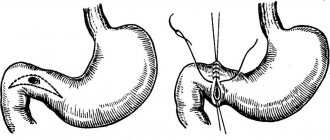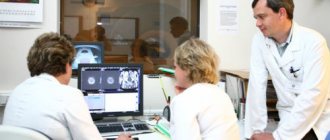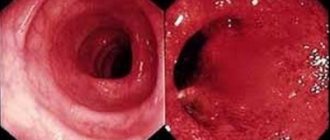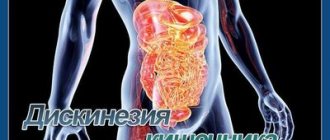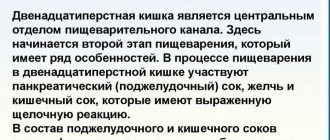Inflammation of the intestine is a collective term that unites diseases that are diverse in their manifestations and etiology. All of them affect one or more parts of the intestine, affecting its mucous membrane and disrupting such an important function as food digestion. The inflammatory process causes hyperemia of the affected area of the mucosa, which disrupts the production of digestive enzymes and the processing of nutrients. How to treat intestinal inflammation?
Types of inflammatory bowel diseases
Intestinal inflammation cannot go away on its own
Among all gastrointestinal diseases, intestinal inflammation ranks second in frequency of occurrence, it affects all age and social groups, and occurs with equal frequency in men and women. According to the location of inflammation, it is divided into the following diseases:
- Enteritis is an inflammatory process that affects the small intestine.
- Duodenitis - inflammation affects the duodenum.
- Colitis – inflammation occurs in the large intestine.
- Enterocolitis - inflammation spreads to almost the entire intestine.
These diseases can be acute or chronic, depending on this there should be a completely different approach and treatment method to them.
Enteritis - symptoms, causes
Acute and chronic inflammation of the small intestine (enteritis) have different causes and symptoms, so it makes sense to consider them separately. The causes of acute enteritis can be:
- Infections (typhoid fever, cholera, salmonellosis, rarely influenza).
- Banal overeating, as well as too spicy or too rough food.
- Poisoning with arsenic or sublimate, other poisons, poisonous mushrooms (fly agaric, toadstool, false mushrooms).
- Consumption of toxically unhealthy foods: stone fruits, mackerel caviar, pike liver, burbot.
- Hypothermia of the body, drinking very cold drinks (directly in accordance with the popular saying “Don’t drink cold things - you’ll catch a cold”).
- Polyhypovitaminosis.
Acute enteritis begins with nausea and vomiting, diarrhea, accompanied by cramps, and strong rumbling in the stomach.
A little later, general weakness and a feeling of malaise appear, the patient breaks into a cold sweat, and the temperature steadily rises. After a few hours, manifestations of intoxication increase: severe headache, increased vomiting and nausea. Acute enteritis has several other causes:
- Irregular and poor nutrition.
- Alcoholism.
- Work in hazardous industries.
- Abuse of spicy seasonings.
- Chronic household intoxication, laxative abuse.
- Uncontrolled and prolonged use of antibiotics.
- Giardiasis, helminthiasis.
- Food allergies.
The symptoms of chronic enteritis are not as bright as in the acute form, but they cause a lot of discomfort. Immediately after eating, there is a feeling of fullness in the abdomen, nausea, dull cramping pain around the navel, rumbling and transfusion in the intestines. During the day there may be 15-20 urges to defecate, which is expressed in foul-smelling, mushy stool with gas bubbles and pieces of undigested food.
The stool has a clay-like consistency and is light yellow in color. After defecation, there may be severe weakness, trembling of the hands, and the person breaks into a cold sweat. Almost always with enteritis, milk intolerance is observed; bloating and diarrhea after taking it are common.
gormed.su
Diseases of the small intestine are so common that many patients treat them extremely lightly and are in no hurry to visit a doctor. This leads to the fact that, for the most part, people with already advanced pathologies are seen by a gastroenterologist. If you experience any symptoms related to the digestive organs, you should make an appointment with a doctor at the Professor Gorbakov Clinic. We receive treatment from the best specialists in this field.
The small intestine is the part of the gastrointestinal tract responsible for the basic processes of digestion. Topographically, it begins immediately after the stomach. The intestines are closely connected with organs such as the liver, gallbladder and pancreas. The small intestine consists of the duodenum, jejunum and ileum. Its loops are located in the upper abdomen.
The most common intestinal diseases are:
- duodenitis;
- duodenal ulcer
- enteritis;
- Crohn's disease;
- dysbacteriosis;
Symptoms of diseases of the small intestine
The main cause of pathologies of the small intestine is the failure of the digestive processes and insufficient intestinal absorption. Therefore, among the symptoms characteristic of these disorders, the following predominate:
- Stool disorder. It can manifest itself in the form of diarrhea or constipation. In severe pathology, traces of blood may appear in the stool and involuntary release of fatty, saturated feces.
- Abdominal pain of a pulling nature and moderate intensity. A distinctive feature is that it intensifies in the afternoon and decreases after defecation. If a patient complains of severe cramping pain, then in most cases we are talking about an inflammatory process in the intestines.
- Another characteristic symptom is bloating. In some cases, it may be accompanied by the sounds of rumbling and fluid transfusion in the abdomen. There is an increase in intensity at night. The body reacts especially acutely to the consumption of foods that cause increased gas formation.
- General clinical symptoms. These include weakness, sudden weight loss, hair loss, swelling and others.
One of the most accurate methods for diagnosing diseases of the small intestine is the study of biopsies taken from the jejunum. They may indicate both the presence of inflammation and the formation of a tumor process. Typically, the sample is taken during a gastroscopy.
In addition, radiography is actively used, during which the swelling of the folds (or their smoothing) and hyperemia of the mucous membrane are clearly visible.
A biochemical blood test is also required; it shows an increase in alkaline phosphatase and active enterokinase, and in more severe forms, a decrease in enzyme activity.
A blood test is characterized by an increase in ROE and C-reactive protein, which indicates an inflammatory process. In addition, a study of the level of immunoglobulins and albumins is carried out.
In order to exclude the infectious nature of the disease, bacteriological and scatological examination of feces is carried out.
An ultrasound of the abdominal organs is performed to exclude concomitant pathologies.
Pharmacotherapy for diseases of the small intestine, the cost of which depends on the nature and stage of the disease, includes the following groups of drugs:
- Antibiotics. They are aimed at destroying pathological microflora and are used with drugs that restore intestinal biocenosis, such as bifidumbacterin or lactobacterin. Their combination with antifungal agents is possible.
- Glucocortecosteroids. They are used for severe disease and are aimed at improving regenerative processes.
- Enzyme preparations. Prescribed for increased acidity and functional failure of the pancreas and gall bladder.
- Medicines that help reduce hypoxia of the intestinal wall.
- Parenteral nutrition consisting of a mixture of amino acids and glucose solution.
- Bismuth preparations. Helps compact stool.
When treating diseases of the small intestine, it is important not only to follow all the doctor’s instructions, but also to follow a proper diet. Thus, it is possible to achieve long-term remission and tissue regeneration after the subsidence of the acute inflammatory process.
Causes and symptoms of duodenitis
Inflammation of the duodenum most often occurs in men. The acute form of the disease often occurs in combination with gastritis and enteritis, and can be complicated by bleeding, peritonitis (due to intestinal perforation) and acute pancreatitis. Chronic duodenitis is combined with food allergies, giardiasis, chronic pancreatitis, ulcerative lesions of the intestines and stomach. With duodenitis, the patient feels the following manifestations of the disease:
- Pain in the pit of the stomach.
- Nausea and vomiting, decreased or lack of appetite.
- Distension and feeling of fullness in the upper abdomen after eating.
If you do not follow the diet and the treatment prescribed by your doctor, the disease lasts a very long time, with frequent exacerbations.
Nutrition during the manifestation of diarrhea syndrome
Rice water will help with diarrhea.
Diarrhea is a symptom of an intestinal disorder that is accompanied by frequent loose stools.
With diarrhea, intestinal motility increases, and it stops absorbing fluid normally. Therefore, you need to eat foods that can reduce intestinal motility and restore its function to absorb fluid.
In the first days of diarrhea, attention must be paid to fluids. Drink plenty of warm water to help rehydrate your body. Healthy drinks include strong tea with lemon, apple juices, alkaline non-carbonated drinks, raisin and blueberry infusions.
On the second day it is allowed to eat crackers without flavoring additives and powders. You need to eat a small portion every hour and drink plenty of liquid. On the third day, you can gradually introduce foods that reduce intestinal motility and are most useful for diarrhea, namely:
- Rice water and liquid porridges. Rice does not contain fiber (which acts as a laxative) and has binding properties. It is recommended to eat one cup of rice water or porridge every 2 hours.
- Bananas. They replenish the body with potassium, which is washed out of the body during diarrhea. To do this, consume 2 bananas every 4 hours.
- Weak meat and chicken broths.
- Porridges that coat the gastric mucosa (semolina, oatmeal, buckwheat).
- White bread crackers.
- Baked or boiled apples (contain elements that bind toxins and restore beneficial intestinal microflora).
- Lean fish and lean meat (no skin, bones or fat).
- Boiled carrots and puree from them. Enriched with vitamin A, which improves the condition of weakened intestinal mucosa and has adsorbing properties.
- Fine-grained low-fat cottage cheese, boiled eggs or steamed omelettes will replenish the body with proteins.
- Vegetable soups and purees.
- Kissels and veins made from fruits and berries rich in vitamins.
Diagnosis of intestinal inflammation
Gastroenterologist is a doctor who treats gastrointestinal diseases
A gastroenterologist should treat intestinal inflammation and should be contacted if the above symptoms appear in any degree of their manifestation. To clarify the diagnosis and to exclude diseases of a different profile with similar symptoms (oncology, infections), the doctor prescribes an examination. This may include:
- Endoscopy of the stomach and duodenum with a biopsy of the mucous membrane, if necessary - the condition of the mucous membrane is analyzed.
- Colonoscopy – using a colonoscope inserted through the rectum, the localization of inflammation in the large intestine is assessed.
- Blood test for ESR (erythrocyte sedimentation rate) - the intensity of the inflammatory process is assessed.
- Coprogram – assessment of intestinal enzymatic function.
- Examination of stool for the absence or presence of bacteria, their sensitivity to groups of antibiotics.
Constipation in children
If a child experiences constipation, especially chronic constipation, treatment should never be delayed. Prolonged bowel retention only aggravates the problem. The feces become dense and damage the intestinal mucosa, which leads to painful bowel movements - as a result, the child endures and deliberately avoids going to the toilet. Accumulating feces stretch the ampulla of the rectum, and encopresis (fecal incontinence) may subsequently form.
Parents are often interested in what to do if a child is constipated at 1 or 2 years old. The situation with stool retention in a newborn, one-month-old baby or infant becomes even more difficult for mothers and fathers. Young children are scared to use laxatives, especially since many of them are contraindicated at an early age.
To eliminate acute stool retention in a child from the neonatal period, MICROLAX® can be used: it has no age restrictions, and is also approved for infants. If constipation occurs, therapy should be supplemented with other measures - diet, increased fluid intake, increased physical activity.
For newborns and infants who receive only mother's milk, the diet must be followed by a nursing woman. When feeding with formulas, it is recommended to use special nutrition. Infants over 4 months of age need to introduce vegetable and fruit complementary foods in a timely manner.
Up to contents
Treatment with modern medicines
In case of acute enteritis, hospitalization is necessary; in a hospital setting, gastric lavage with a tube and bowel cleansing with laxatives are required. Acute intoxication is treated by drip administration of Ringer's solution, Trisol, and glucose. The intestinal flora is restored with the help of Intestopan, Bifikol, Colibacterin, Enteroseptol.
In case of chronic enteritis, antibacterial agents are not used to avoid dysbacteriosis. The flora is restored with the help of Linex, Bifidumbacterin, Lactobacterin. Panzinorm, Meksaza, Abomin, analogues of Enteroseptol, Intestopan are used. Diarrhea is stopped with drugs such as Imodium, Loperamide.
Acute colitis of infectious origin is treated in a specialized department of the hospital, where patients undergo a course of antibacterial therapy. For other forms of colitis, enveloping drugs (Kaolin), astringents (Bismuth drugs), and enzyme drugs (Bifikol, Colibacterin, Linex) are prescribed.
In chronic colitis, the main focus of therapy is aimed at normalizing the intestinal microflora. The patient is first given the shortest possible short course of antibiotics to destroy pathogenic microorganisms. Then treatment with eubiotics and probiotics occurs.
